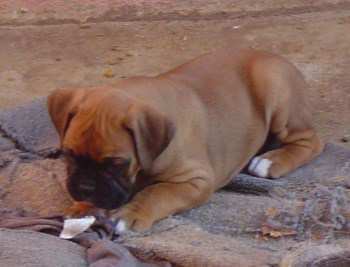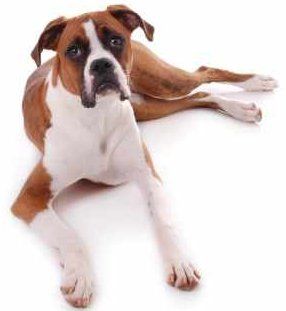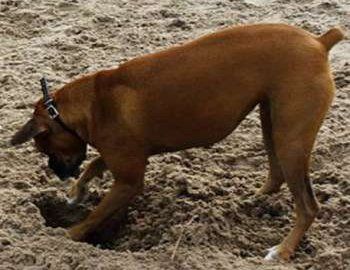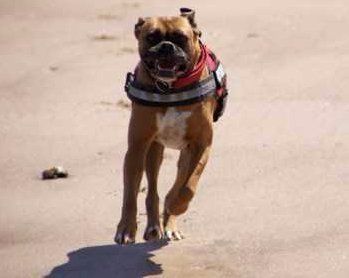When a Boxer Dog Seems too Skinny
The Boxer Dog Skinny Phase
The Boxer breed is naturally a lean, slim dog with tightly packed muscles. However something funny can happen to a Boxer dog when he transitions from puppyhood to adulthood. There is a temporary period of time that the Boxer can look a bit too skinny, sometimes with ribs showing.
This most often occurs between the age of 14 and 22 months and leaves owners wondering why their Boxer is too skinny and doesn't have good muscle ratio.
In most cases, this is totally normal; it is a brief 'stall' that is an awkward, adolescent stage. Owners will often notice that their Boxer eats a lot but can't gain weight. Rest assured, this is almost always normal and isn't indicative of a medical issue.
Here, we will discuss:
• Why this happens
• Medical issues to rule out
• How to help your Boxer gain a bit of weight and fill out as expected
Why Boxers may Look Skinny
When a Boxer is a puppy, he has a nice rounded appearance. It's normal for there to be an extra layer of 'puppy fat' and muscles are not yet defined. He has a long way to go to have his strong, adult
appearance. A Boxer dog can have a temporary phase of looking too skinny because there is a window of time in which puppy fat is lost and the dog rapidly grows in height. This happens before his/her muscles become defined.
During this short window of time, a Boxer will have a healthy appetite and be as active as ever. However, he/she may be exceedingly lean, sometimes with the rib cage being visible. Since visible ribs are usually a clear sign of being underweight or malnourished, this can be troubling to owners. However, in most cases the dog is eating plenty and the only issue is that his body needs time to bulk up.
From this young age up until the age of 2 years old, the Boxer will gradually fill out. His chest will widen. His muscles will become more defined and thick. And importantly, he will 'fill in' around the chest with a healthy, thin layer of fat, tissue and muscle that will cover the rib cage once he become an adult.
The level of skinniness in adolescent Boxers will vary, so with those with skinny legs, chests and necks will need more time to bulk up then those that only look a bit too lean in the rib area.
The important element to keep in mind is that baring any health issues, a Boxer dog will gain weight and lose that skinny appearance as long as he eats well and has opportunity to work his muscles.

Boxer puppy with a nice, round appearance as expected.

A slim, slightly skinny adolescent Boxer

Thick, strong and lean.
Ruling Out Health Issues
While it is not uncommon for a Boxer dog to be skinny for anywhere from 2 to 10 months while he is transitioning from puppy to adult, it will be important to rule out any possible health issues before you take a few steps - and have some patience- for him to gain a bit of healthy weight.
Possible health conditions include but are not limited to:
• Thyroid issues
• Parasites (worms)
• Inflammatory bowel disease
• Disease of the pancreas
• Liver or gall bladder disease
• Heart conditions
• Liver problems
• Kidney disease
• Addison’s disease
• Diabetes
• Immune system problems
The Boxer should have a complete physical along with stool and blood testing. Also, even if your dog has recently been to the veterinarian, you'll want to have your Boxer examined if he/she seems too skinny and additionally has any of the following issues:
• Moderate to severe loss of appetite (Boxers that are a bit too skinny simply due to the normal growth stage will eat as normal- or just a tad
less - as the body temporarily stalls before filling out)
• Vomiting, dry heaving
• Diarrhea or any changes in stools
• Dry skin
or dry coat issues
• Changes in mood or energy level
Helping a Skinny Boxer Gain Weight
Keeping in mind that this is often due to a 'skinny phase' that happens when a Boxer matures from puppy to adult, there are some steps you should take. The main goal will be to maintain or improve his/her diet - with a slight increase of calories but not quality - and keep the Boxer as healthy as possible while waiting for the skinny stage to end.
1) Reevaluate what you are feeding your Boxer. While a Boxer should be fed a super high quality food at all times, when he/she is underweight and trying to fill out into his adult frame, this is more important than ever. A cheap food with fillers will be brutal on a Boxer that is in his/her skinny phase.
2)
You don't want to try and force a Boxer dog to eat more food than he already does and most Boxers that are too skinny are already eating you out of house and home… So the goal will be to offer the same amount while offering more calories
via wholesome, healthy ingredients. This can be accomplished by adding one or more of the following to meals:
• White water-packed tuna
• Sardines
• Cottage cheese
• And/or a whole egg (with the egg, you may opt to add the shell as well - If you do, you'll want to place the shell pieces into a sandwich bag and use a rolling pin to crush it into fine pieces)
While rice and pastas have their place in a healthy diet (carbs are needed for energy), you'll want to avoid adding any extra rice/pasta/breads since they will bulk up the food but won't offer as many protein-rich calories as the foods listed above.
A scoop of peanut butter -eaten off a wooden spoon- or stuffed into a Kong along with fruit & vegetable pieces and banana slices is a great, healthy snack. As a side note, be sure to use a proper toy cleaner to scrub out the gook and gunk that will accumulate inside Kongs and other treat-release toys.
Homemade Snack to Help Boxer Dog Gain Weight:
Since this involves routinely giving a mix of calorie dense food that is higher in fat than recommended for canines, run this by your vet first. Please note that these are not for meals. Feeding this for full meals could lead to upset stomach, diarrhea
and very fast, unhealthy weight gain.
Cook 1 pound of ground beef (70% lean), 8 scrambled eggs, 3/4 cup of ground flaxseed, 1 cup cooked oatmeal (plain), 8 ounces of cottage cheese, 1 cup of peanut butter and 1 tablespoon of molasses. Mix very well. Form into teaspoon sized balls. Please on a cookie sheet and freeze. Once frozen, store in airtight containers like Tupperware. Give thawed balls as snacks. 1 to 3 per day.
3)
If your Boxer's appetite is waning at the same time that he is looking a bit skinny - but has no health issues, this may be a matter of a dog's appetite slightly decreasing because a rapid growth phase stopped. When he was quickly growing in height, he was eating a lot. Now, in this 'skinny limbo' the Boxer has a stall of growth and his body doesn't need as much food. His appetite may not increase again until the body breaks free from the skinny phase and starts to grow in width and thicken up.
Again, you don't want to force a Boxer to eat. With that said, adding a drizzle of warm low-salt chicken or beef broth can make a meal a bit more tempting. Alternatively, serving the entire meal warmed up can make it more appealing. Using the microwave is just fine; but be sure to mix it up well and test it with your inner wrist to make sure it's not too hot before scooping it into your Boxer's food bowl.
4)
Allow your Boxer dog opportunities to stretch and grow his/her muscles.
While daily walks are an important part of care, allowing your Boxer a space to run is great for the body. Taking a weekly walk in the sand (beach shoreline or lakeside) is a great way to help the Boxer dog find his power.
5)
If these steps do not help, you may want to consider using a high calorie nutritional supplement. In conjunction with the food that you feed your Boxer, this can be just the boost that dog needs. You can learn more in the Boxer Dog Supplement
section.
The End of the Boxer Dog Skinny Phase
If you have had health issues ruled out and you are feeding your Boxer well and providing enough exercise
opportunities, all you will need now is some patience.
Your adolescent Boxer is a slimmed version of the adult he or she is soon to become.
Keep in mind that this breed is a lean dog and Boxers will vary; some will have wider chest than others. Some will have thicker legs and thicker necks than others.
With most
adults, the ribs will not show, however they may be slightly visible when the dog turns or positions himself a certain way. At a healthy, adult weight, you will be able to feel the ribs, but not clearly see them.
Once your Boxer reaches the 3 year mark, he/she will have their adult physique.
With good food and care, that will be maintained until the senior years at which time there will be a gradual muscle loss which makes a Boxer's body look less well-defined and a just a bit softer.


